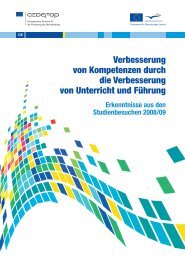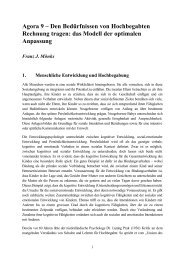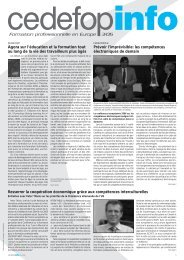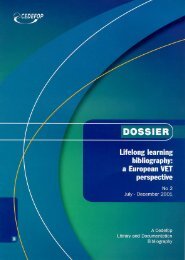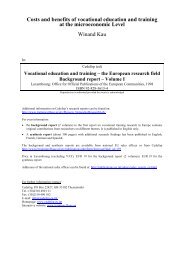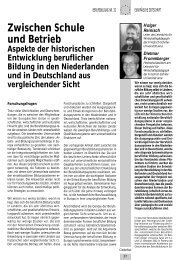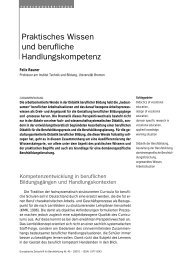Full text (pdf) - Cedefop - Europa
Full text (pdf) - Cedefop - Europa
Full text (pdf) - Cedefop - Europa
Create successful ePaper yourself
Turn your PDF publications into a flip-book with our unique Google optimized e-Paper software.
188<br />
European journal of vocational training<br />
No 42/43 – 2007/3 2008/1<br />
This table needs to be complemented by a more nuanced consideration.<br />
The European Qualifications Framework serves as a reference point to make<br />
the individual National Qualifications Frameworks (NQF) or qualifications comparable<br />
with one another (bilaterally and multilaterally). The NQFs or qualifications<br />
of different systems are compared with each other by means of the<br />
EQF meta-framework, which facilitates their transfer to other systems. The<br />
EQF operates as a passive instrument in this sense. The key role of the EQF<br />
in the implementation of the European Union’s overall education strategy finds<br />
expression in particular through its links with other instruments of transparency<br />
(the European Higher Education Area Qualifications Framework, <strong>Europa</strong>ss,<br />
ECTS, ECVET, principles for the validation of non-formal and informal learning<br />
(Schneeberger, 2006)).<br />
Credit systems are devised as instruments which are broadly and directly<br />
applicable in a mobility con<strong>text</strong>, by way of ‘all-in-one’ or ‘ready-made’ solutions,<br />
even though they may develop further over the years, as ECTS has<br />
done. Credit systems serve a number of general purposes:<br />
transfer of learning outcomes within and between education systems, or<br />
of learning outcomes acquired in formal and informal settings;<br />
accumulation and mutual recognition of learning activities or partial qualifications<br />
until the qualifications are completed;<br />
cooperation between VET providers across national borders;<br />
transparency of learning processes and learning outcomes through joint<br />
adherence to the EQF;<br />
flexible accreditation of study periods, study programmes and curricula by<br />
independent decision of the competent (national) bodies;<br />
as far as possible, simplification and activation of certification and validation<br />
procedures at all levels (<strong>Cedefop</strong>; Le Mouillour, 2005).<br />
ECTS relates to the higher education sector, while ECVET is intended for<br />
VET (in particular initial training) in the first instance; both will also be applied<br />
in the field of lifelong learning at a later stage (European Commission, 2004;<br />
European Commission, 2006b). For the time being, ECTS and ECVET differ<br />
in scope and coverage. This becomes clear when one examines their respective<br />
definitions:<br />
The ECTS was conceived on the basis of the following definition: ‘A credit<br />
system is a systematic way of describing an educational programme by<br />
attaching credits to its components’ (European Commission, 2004, p. 1);<br />
ECVET is ‘a mechanism designed to facilitate learners’ mobility by supporting<br />
cooperation among partner organisations in the international ac-




